Clive Rees’ The Blockhouse (1973) and other recent Indicator releases
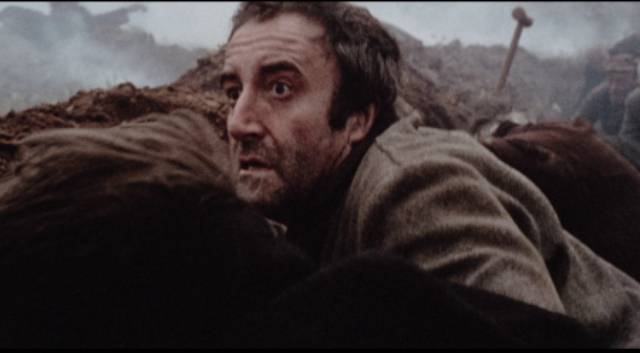
Maybe it’s a fairly normal human tendency, but I look for patterns and when I can’t see something clearly I get confused. I have no idea what’s going on with Indicator, but recent releases seem to have little rhyme or reason when viewed in the aggregate. There’s even an upcoming box set of disreputable British sex comedies from the ’70s. Not the “top tier” Confessions of… series starring Robin Asquith, launched in 1974 by Val Guest’s (oh, how the mighty have fallen!) Confessions of a Window Cleaner, but Stanley Long’s low-rent Adventures of… trilogy (1976-78). I buy and watch a lot of rubbish, but I do wonder what went into the decision to unearth these movies and lavish Indicator’s usual care on restorations and supplements.
The past month brought a very odd mix on the heels of Gerry O’Hara’s The Brute. Some of these are of dubious artistic merit, and most of them quickly disappeared into commercial oblivion, with limited theatrical release (and in one case no release at all). Of course, box office take is no measure of a film’s intrinsic value, so my interest here is in the creative accomplishment of the filmmakers – in itself, widely varied among these five titles.
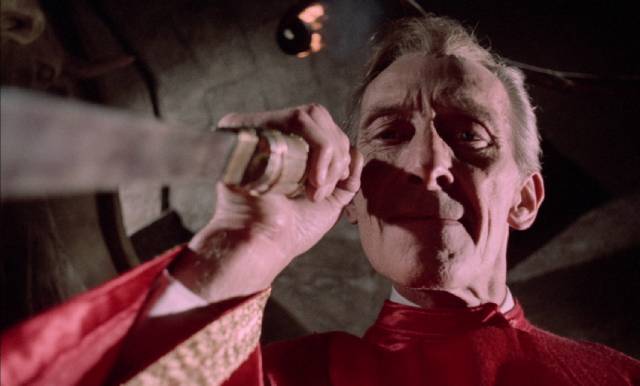
The Devil’s Men (Kostas Karagiannis, 1976)
Over the years, largely thanks to DVD and Blu-ray, I’ve discovered a number of interesting genre movies from various European countries, many of which had some kind of English connection for commercial reasons – there’s the work of José Ramón Larraz, Narciso Ibanez Serrador, Jorge Grau and Eugenio Martin in Spain, Jean Rollin in France, Mario Bava and a cohort of his compatriots in Italy. So I’m always interested when something unknown turns up, hoping for another Who Can Kill a Child? or Living Dead at Manchester Morgue. The Devil’s Men (1976), a Greek-British co-production, doesn’t meet that target.
There are, however, two interesting points about this movie. The first is that the production company was a joint venture between Greek producer Frixos Constantine and the great filmmaker Michael Powell, who by this time had been struggling to maintain some kind of career after the savage reception given to his masterpiece Peeping Tom in 1960. Director Kostas Karagiannis, although halfway through a very prolific career, displays none of Powell’s talent. The second point is that this movie was Brian Eno’s first stab at creating a soundtrack; not unsurprisingly, this is not in the least conventional, and barely counts as music at all – rather, it’s an ominous soundscape of tones and ambiences which create an underlying sense of unease which the movie otherwise lacks.
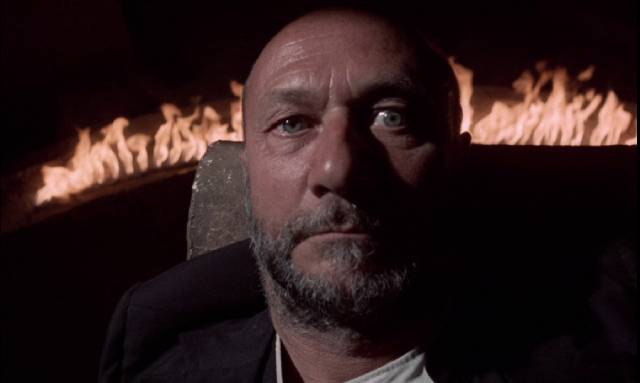
The Devil’s Men (aka Land of the Minotaur) does have a few interesting moments and suggestive images, but it’s very underwritten (by television writer Arthur Rowe) and so sluggishly paced that whatever potential atmosphere and tension the material promises never materializes. The chief interest lies in the casting of Donald Pleasence as the hero and Peter Cushing as the villain, a reversal of expectations. Following the death of his wife in 1971, Cushing had struggled to keep going, but then threw himself back into work, appearing in dozens of movies and TV shows. While he remained a fine technical actor, however, it was apparent that his heart wasn’t always in it – and that seems to be the case here, as he goes through the motions as leader of a pagan cult on a Greek island who presides over the ritual sacrifice of young tourist couples in an underground temple. These sequences, dominated by a golden Minotaur statue breathing fire from its nostrils, with the sacrificial altars surrounded by cult adherents in red robes, provide cinematographer Aris Stavrou with his only opportunity to create some interesting imagery, everything else wavering between perfunctory and travelogue-picturesque.
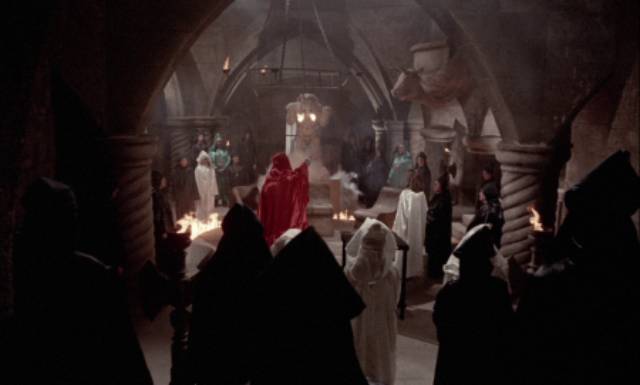
Pleasence as a Catholic priest who uncovers the cult’s activities as he searches for some former students who have disappeared, does what he can to inject some energy, but there’s little room for him to generate the kind of quirky intensity which makes many of his performances so entertaining. The rest of the cast is pretty generic (only Luan Peters is familiar, having previously done a couple of Hammer’s Karnstein movies and Pete Walker’s The Flesh and Blood Show). Worst of all is ostensible lead Kostas Karagiorgis, a former protege of the priest, now a private eye in New York, who returns to the island to help his old friend find out what’s happening to the young tourists. He’s abrasive and irritatingly lacking in curiosity about what’s going on, disbelieving everything he’s told until it’s impossible to ignore the reality of the cult any longer.
Despite little to recommend it, Indicator have lavished their usual attention on this minor effort. There’s a commentary by critics David Flint and Adrian J. Smith; a lengthy audio interview with Cushing from 1973 (92:00); an interview with producer Frixos Constantine (7:48); and a super-8 home viewing copy which, unusually, is full length instead of simply excerpted (1:33:20). The feature is presented in two versions, the original 94-minute theatrical and the shorter U.S. cut (86 minutes).
*
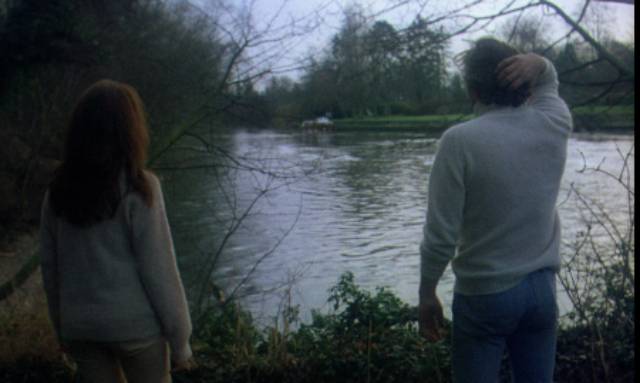
Voices (Kevin Billington, 1973)
Kevin Billington’s Voices (1973) is an oddity, interesting more for its echoes of other things than its own achievements. Adapted from a one-act play by Richard Lortz, apart from an added prologue and epilogue, it remains stagebound; the fact that the production “innovated” by having the frame shot on film while the body of the story was shot on video on obvious sets (or rather, an obvious single set) and then transferred to film gives it the overwhelming feel of a television play. It may have worked better in that context – before Lortz adapted it for the stage, it was in fact an episode of Thames Television’s long-running Armchair Theatre. That episode was called “The Others”, a title which strangely, in retrospect, gives away the final reveal for anyone who has seen Alejandro Amenabar’s 2001 feature The Others.
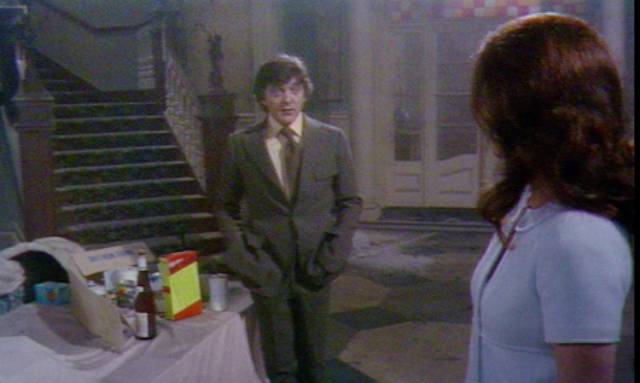
That weird time-displaced echo is just one sliver of the movie’s sense of deja vu. The opening section is similar to the beginning of Nicholas Roeg’s Don’t Look Now, released four months later. On holiday, Robert (David Hemmings) and Claire (Gayle Hunnicutt) tie their houseboat to the bank of a river just below a fast-running weir. After lunch, they retire to the cabin for some relaxed sex while their young son John (Russell Lewis) goes exploring. Playing with a stray dog, the boy removes his life jacket and walks across the wooden bridge over the weir. Eventually emerging from the cabin, the couple realize that their son has disappeared and scour the wooded banks. The boy is never found.
Cinematographer Geoffrey Unsworth gives this sequence a great deal of tension, with its watery overcast light and ominously turgid river. The cutting back and forth between the couple’s intimacy and their son’s careless play is less stylized than Roeg’s intricate editing but evokes a similar sense of anxiety – much like Lars Von Trier’s more graphic depiction of the same parental fear and grief in Antichrist (2009). But neither the script nor Billington’s direction can maintain the intensity of this opening. We next see Robert and Claire driving on a narrow country road in thick fog, intercut with flashes of what may be years of intervening time during which Claire has attempted suicide and been consigned to a psych ward because she’s unable to get past her grief.
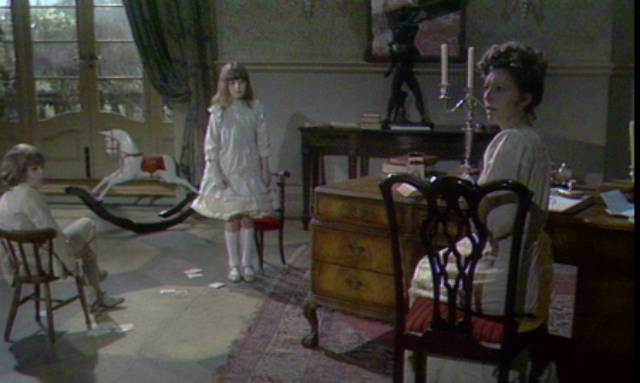
They’re heading for a gloomy old country house Claire has inherited from an aunt, hoping a weekend getaway might help to ease the stress on their marriage. After a close call on the road, they walk the final stretch through fog-shrouded woods, finally reaching the house – and abruptly stepping through the door into a set and a flat shot-on-video look. The tonal and stylistic shift is jarring. Now all we have is Hemmings and Hunnicutt and a rather thinly-written script (adapted by producer Robert Enders and TV writer George Kirgo) which has the couple bickering repetitively. Robert wants to move on from John’s death, but Claire can’t let go.
In fact, her continuing attachment and emotional fragility seems to open her up to contact from “the other side”; she begins hearing voices in the house (unheard by the thick-headed Robert, just like Donald Sutherland’s John in Don’t Look Now) and eventually sees children playing, who in turn suddenly see her, although their mother doesn’t believe them. After picking at each other in a superficial George-and-Martha (Who’s Afraid of Virginia Woolf?) way, Robert and Claire finally leave the house and, the fog now gone as we switch back to film, walk back to the car to discover the truth about their situation.
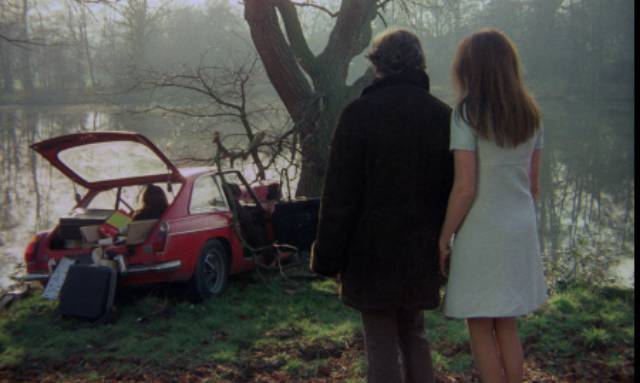
Aside from the technical oddity of a feature film mixing film and video back in the early ’70s, the dramatic limitations of the script prevent the movie from ever finding depth in the couple’s psychological conflict or suspense in the apparent haunting. What interest it does have comes from outside, from the knowledge that real-life husband and wife Hemmings and Hunnicutt were going through the disintegration of their own marriage at the time of production, that they were perhaps working out their own emotional conflicts through these underwritten characters.
I may make time to listen to the commentary by Barry Forshaw and Kim Newman, but haven’t heard it yet. The disk’s other extras are a discussion by Vic Pratt of Hemdale, the production company Hemmings had formed with producer John Daly (17:45); a brief reminiscence of Hemmings by filmmaker Peter Crane (destined for his own Indicator box set in May) (7:26); and a four-minute piece about the challenges of restoring a film largely shot on video (3:39).
*
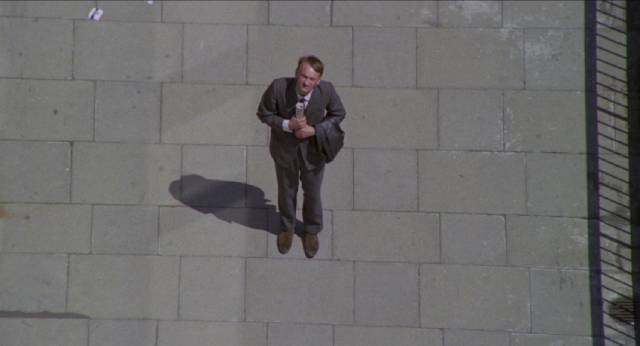
Bartleby (Anthony Friedmann, 1970)
It’s been a long time since I read Herman Melville’s story Bartleby the Scrivener, but it still seems vivid in my memory. Written in the early 1850s, it seemed startlingly modern in its depiction of alienated labour in a society dominated by industrial capitalism, in which human activity had been subdivided into compartmentalized meaninglessness. Hired as a copyist by a busy attorney, Bartleby begins as a skilled and efficient employee, but quickly starts to resist the mind-numbing demands of the job. When asked to perform a task, he says calmly and politely “I would prefer not to.” His employer is puzzled and eventually frustrated, but Bartleby’s calmness and politeness forestall confrontation, anger and the assertion of power. Unable to fire Bartleby (he says it would be “inconvenient”), the employer chooses instead to move his office to another location. He eventually hears that Bartleby’s refusal to participate in this society has extended to a refusal to continue living; no longer eating, the young man has quietly starved to death.
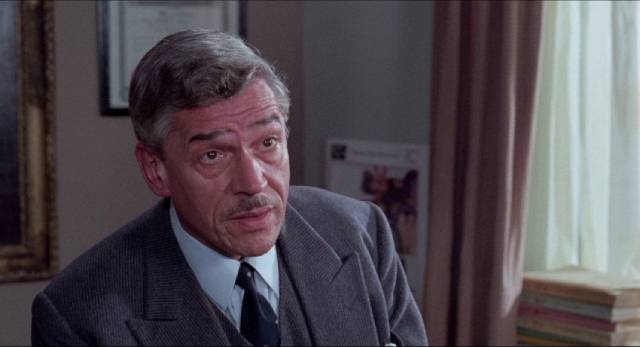
Although Bartleby’s resistance to the constraints imposed on a worker in this economy is ultimately self-defeating, his (in)action shakes his employer’s certainties about the world and the roles assigned to its inhabitants. That this vision of alienation was written in the mid-19th Century seems remarkable and prescient. The point Melville was making has been absorbed into our cultural consciousness so thoroughly that its revelation now seems obvious; indeed, without a full awareness of the story’s original context it may strike a reader as almost trite. Which is why I am quite ambivalent about Anthony Friedmann’s 1970 adaptation.
Friedmann’s script, co-written with producer Rodney Carr-Smith, adheres quite closely to the story, but relocates it from 1850s New York to late-’60s London, a place where Melville’s insights have long-since become common wisdom. While this suggests the “timelessness” of those insights, it strips away any sense of original revelation. Given how alienation had become a deeply embedded theme in 20th Century life and art, Bartleby’s passive resistance seems oddly old-fashioned. By 1970, the fraught conflict between labour and capital had produced great upheavals in society (to shortly be crushed back into lasting imbalance in capital’s favour by Margaret Thatcher in Britain and Ronald Reagan in the United States), so Bartleby’s lonely opposition to his boring role going over other people’s account ledgers seems futile and self-indulgent rather than deeply unsettling to the status quo.
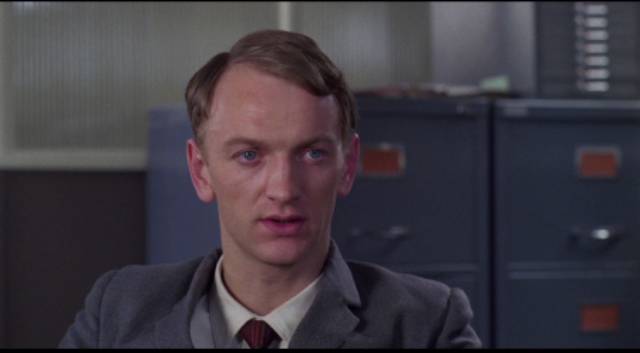
Watching this small chamber piece, a sense of the obvious is unavoidable, and yet there is pleasure in the two lead performances. Paul Scofield, a theatre actor who rarely worked in movies, was returning to the screen four years after his Oscar-winning turn as Thomas More in Fred Zinneman’s A Man for All Seasons (1966) – he also made the much more demanding King Lear with Peter Brook in 1970 – and he adds a sense of confused intelligence to the employer’s inability to deal with Bartleby’s resistance. John McEnery as Bartleby has the trickier role; the roots of his resistance remain opaque – we know nothing about him – and so Friedmann resorts to imposing external signifiers to explain him; the bustle of big city life, the effects of pollution on the environment, images of people as cogs in the industrial machine. Friedmann begins the film with Melville’s final revelation, Bartleby’s previous job in the post office’s dead letter department, a symbolically loaded setting which, rather than providing a belated explanation as in the story, merely suggests that taking a job in an office is a form of escape which fails.
In the story, Bartleby’s resistance is an expression of paradoxical strength and resolve; in the film, McEnery’s Bartleby is fearful and lost, his resistance not so much a form of action as it is an attempt to escape from the need to act. While the movie obviously displays a sincere and serious attempt to adapt Melville’s story, it nonetheless seems hopelessly at odds with its source. In trying to display the story’s universality, it instead reduces it to a trivial footnote. Perhaps an interesting failure, it’s worth watching for the performances and for its glimpses of London at the end of the ’60s.
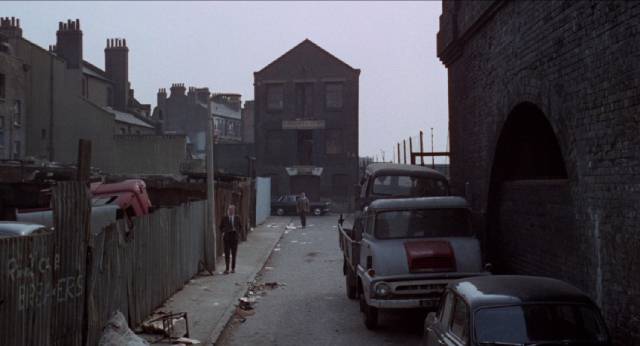
This was Friedmann’s only dramatic feature. He apparently had a successful career as a producer in advertising and industrial filmmaking – the disk includes an interesting example of the latter in Beat the Bomber (16:09, 1975), a training film for retail workers made at the height of the IRA’s mid-’70s terror campaign, showing how to spot the planting of bombs in stores and how to react effectively to potential danger.
The disk also includes an audio interview with Friedmann (14:32), a visually interesting stop-motion adaptation of Bartleby (2017) by Kristen Key and Laura Naylor, which compresses the story to a brief 11:25, a short featurette on the feature’s locations (3:37) and several image galleries.
*
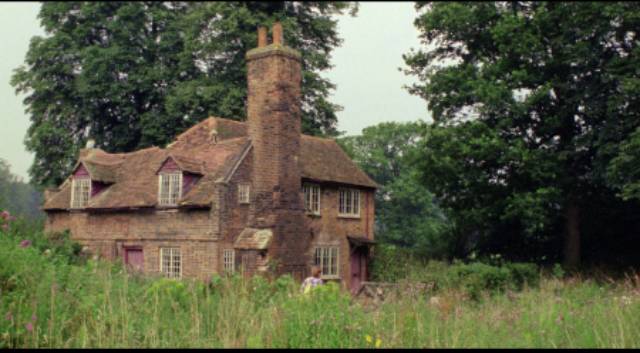
in Chris Petit”s An Unsuitable Job for a Woman (1982)
An Unsuitable Job for a Woman (Chris Petit, 1982)
Christopher Petit, a former film critic, deliberately and aggressively went against the inertia of the British film industry with its polished costume dramas and literary adaptations when he made his first feature. Radio On (1979) looked abroad to the New German Cinema, and Wim Wenders in particular, for its inspiration. In fact, Wenders was one of the producers; Martin Schäfer, a former assistant to cinematographer Robby Müller on a number of Wenders’ films, did the camerawork; and Lisa Kreuzer, a favourite of Wenders, was a co-star. Petit applied Wenders’ bleakly poetic existential angst to Thatcherite Britain in a road movie which begins with a purpose (a man heads across England to discover the cause of his brother’s death), but through a series of random encounters disintegrates as a narrative in emulation of the fragmentation and decay of the nation under a regime antithetical to communal cohesion.
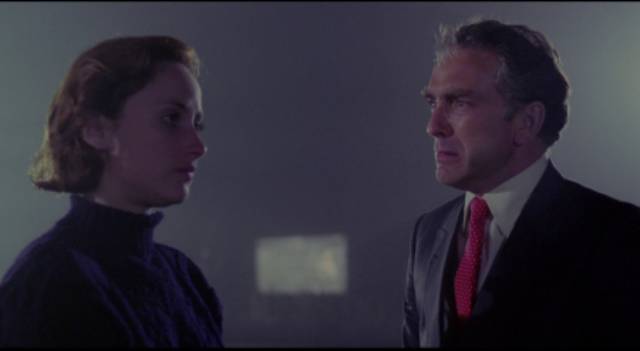
Although successful on the festival circuit (I saw it at the 1981 Hong Kong International Film Festival and became an immediate fan), the film was probably too stark and depressing to find much commercial success. It took Petit a couple of years to put together a follow-up project, one which was deliberately conceived to be more commercial. He searched for a mystery novel or thriller to adapt and eventually settled on a P.D. James novel, the first of two featuring a female private detective. Cordelia Gray (Pippa Guard) is only in her early twenties when her boss commits suicide and bequeaths her his detective agency. Determined to make a career for herself, she takes a job for businessman James Calendar (Paul Freeman), whose son apparently committed suicide. Moving into the remote cottage where the death occurred, Cordelia becomes increasingly obsessed with the dead Mark Calendar (Alex Guard) as she begins to dig into the circumstances of his death.
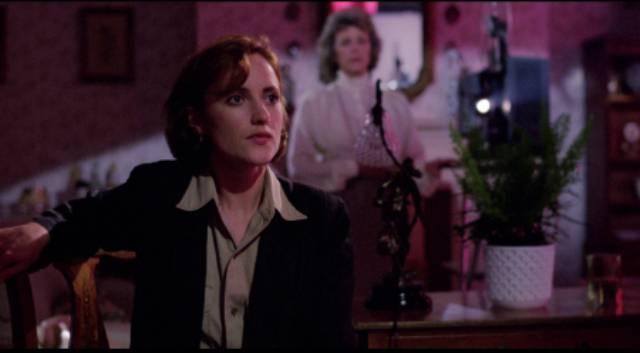
Needless to say, there’s more to Mark’s death than is first apparent, and in time-honoured fashion Cordelia uncovers unsavoury family secrets. But Petit, despite the commercial intentions, is not that interested in the mechanics of the plot. There’s almost a fairy tale quality to Cordelia’s experiences in the cottage; a distant cousin to Alice, she slips through the looking glass to find herself in an alternate world where people are never what they seem, social positions are skewed, and emotional attachments to the dead supersede relationships with the living. Rather than evoking the rational procedures of a detective tale, Petit’s mise-en-scène and editing continually suggest a horror film. Resolution eventually comes about through Cordelia’s emotional engagement with the dead Mark and a sense of identity with Calendar’s assistant Elizabeth Leaming (Billie Whitelaw), whose role in a complicated family narrative brings the situation to a violent conclusion.
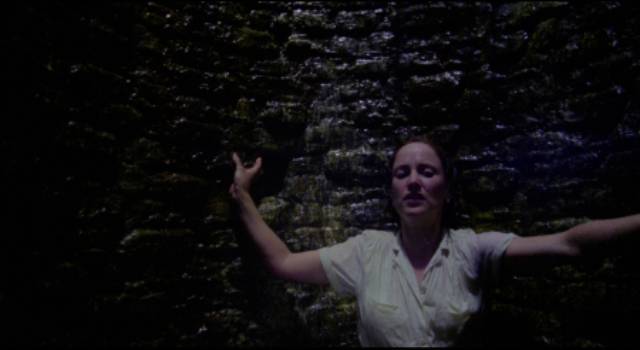
An Unsuitable Job for a Woman was not a commercial or critical success. Petit’s own creative interests undermined genre expectations; his background as a critic perhaps inevitably nudged him towards deconstruction rather than reiteration – for his third feature, Flight to Berlin (1984), he went even further in confounding audience response by withholding a great deal of information as his protagonist flees England for Germany and, as in Radio On, undergoes a range of encounters which may or may not eventually resolve into some understanding. What matters to Petit are the momentary details of behaviour which illuminate the alienation running deep in contemporary life, but perhaps even more importantly his interest lies in how cinema itself can capture these moments and make tentative sense of the fragmented social landscape.
It perhaps makes sense that Petit has mostly made documentaries and essay films since the ’80s, including collaborations with authors J.G. Ballard and Iain Sinclair.
As usual with Indicator, the transfer is excellent and there are three interviews included on the disk which provide an interesting account of the production and reception of the film – Chris Petit (29:36), producer Don Boyd (31:12) and actor Dominic Guard (12:47), cousin of Pippa and her brother Alex Guard.
*
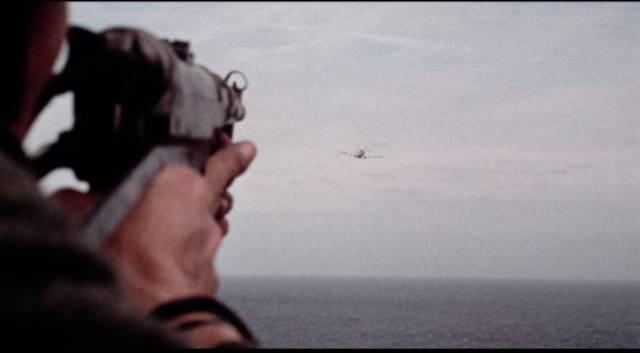
The Blockhouse (Clive Rees, 1973)
If Chris Petit attempted to make some concessions to a mainstream audience with An Unsuitable Job for a Woman, Clive Rees seems to have wilfully gone in the opposite direction with The Blockhouse (1973), the first of only two features made during a successful career in commercials. Relentlessly bleak, this film, loosely based on an actual incident, gives the audience almost nothing to hang onto while raising inappropriate expectations with the casting of none other than Peter Sellers and Charles Aznavour in prominent roles. The film got almost no distribution and vanished from sight for decades, but revived now by Indicator, it can be seen to be a finely-crafted yet relentlessly despairing study of men trapped in a hopeless situation and gradually losing every vestige of socially defined identity.
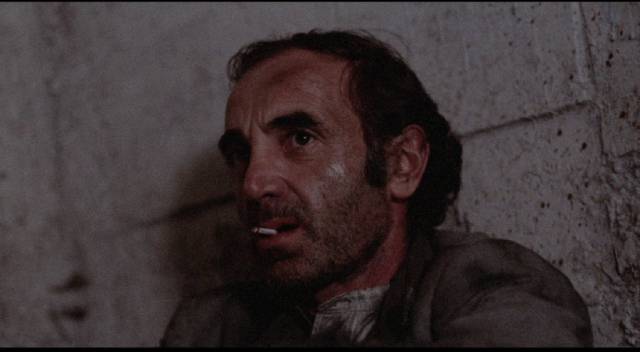
In 1951, two German soldiers were found to have been living for six years trapped in a bunker with adequate food supplies, but no way out. Four others had died, and these survivors had spent the last two years in complete darkness, their supply of candles having finally run out. One of the men died immediately on emerging into sunlight. This story was turned into a novel by French author Jean-Paul Clebert in 1955, which in turn was adapted by Rees with television writer John Gould (who the following year adapted Algis Budrys’ novel Who? for Jack Gold). While keeping the core of the original incident, the novel and adaptation move the story to the coast of Normandy where a collection of French and Polish prisoners in a work camp prepare fortifications for the Germans. During an aerial attack connected with the D-Day landings, seven prisoners find themselves sealed in the huge underground bunker, a combination storehouse and field hospital.
The opening section, with the attack making no distinction between German soldiers and prisoners as the bombs drop and fighters strafe the ground, is an intense, bravura piece of filmmaking which belies the film’s modest budget. The sense of chaos and imminent death produce feelings of relief as the men find themselves down below in a maze of tunnels and concrete chambers; the realization that they are trapped only slowly dawns on them.
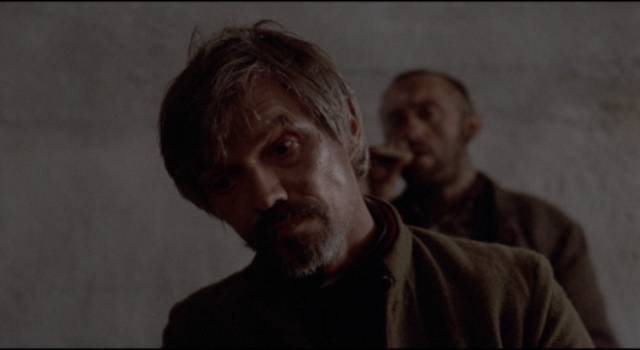
Initially, they experience a kind of euphoria, sealed away from the Germans with a large supply of food, and even better a vast quantity of wine. As they break the necks off the bottles and gulp the wine, tearing into hefty chunks of cheese and sausage, filling up on things their captors had kept from them, only Aufret (Peter Vaughan), the prisoner trustee, is filled with fear that the Germans will come along at any moment and kill them all for looting. But no one comes, and time drags on. One of the men, Lund (Per Oscarsson), fills his time by hacking at the concrete around the ventilation pipe with a crowbar, knowing that there’s no way to dig his way out, but grateful to have something to do.
With water limited to what accumulates through condensation, they wash with wine, becoming grubbier as the days pass. Hair needs to be cut off because there are lice. They sleep, they eat, they play cards, they read … all by candlelight, with the bunker stretching away into darkness around them. Aufret goes mad and dies and they bury him beneath sacks of flour. They bicker, they try to get away from one another. A tentative affection develops between Grabinski (Jeremy Kemp) and Kramer (Nicholas Jones), though it’s left unclear whether this reaches the level of an actual sexual relationship – whether because the men can’t overcome their own reticence, or because the filmmakers are unwilling to go that far in 1973 is unclear.
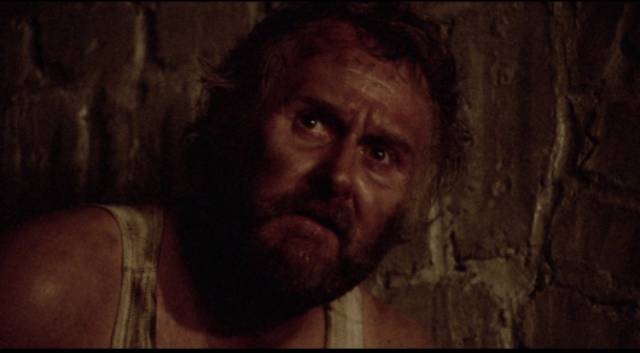
And so time goes on, grinding them down – days turn to weeks, weeks to months, months to years. It’s one of the film’s strengths that it manages to convey both this passage of time and the oppressive timelessness of being forever in this place where nothing ever happens. Madness overtakes some, a simple inability to go on. There’s no philosophical introspection about the meaning of life in a place devoid of external stimulation, just the sheer physicality of concrete, of flickering candlelight, the processes of bodies with nothing to do but eat, drink, sleep, piss and shit. Only once is there a break in the monotony; one of the men finds a bicycle and they line the tunnels with candles to create a track, taking it in turns to race against a watch, timing one another, until one of them loses control and crashes, wrecking the bike.
When the candles finally run out and the two survivors sink into perpetual darkness, the blank screen eventually fades up to a view of the coast and the concrete blockhouse perched on the cliff as on-screen text tells us that another two years passed before the two survivors were discovered – one died immediately on reaching the surface, the other lingered for thirty-six hours in hospital before also succumbing, their six years underground having stripped away their ability to live in the world they had long since left behind.
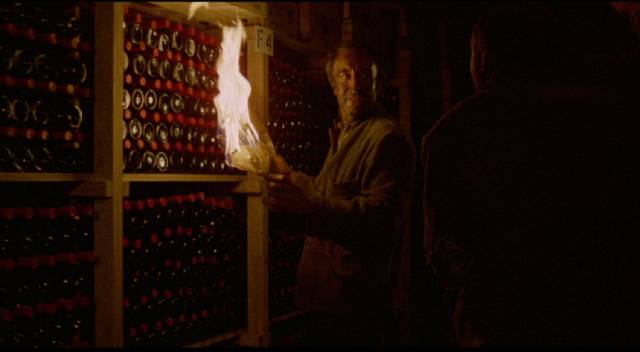
How could anyone – director Rees, producers Antony Rufus Isaacs and Edgar M. Bronfman Jr (the latter heir to the Seagram’s empire, only nineteen at the time of production), and the actors – have expected this to have any commercial prospects? And yet, Rees’s direction is excellent, cinematographer Keith Goddard’s imagery nightmarishly effective, and the performances chilling in their authenticity. Filmed in an actual German bunker on Guernsey, with very little lighting beyond those candles, the dank, claustrophobic atmosphere traps the audience with these characters, instilling the viewer with their ever-increasing hopelessness. Dialogue maintains a mundane ordinariness rather than striving for any literary effect – itself something criticized by reviewers. And yet that inexpressiveness makes the performances more effective and poignant than they might have been if these men spent those idle hours ruminating on the meaning of life.
The cast disappear into these otherwise unexceptional characters. Which is another reason the film wasn’t well received. Knowing that The Blockhouse starred Peter Sellers, with a French accent no less, raised expectations of Clouseau-like farce, and here he was as Rouquet, a quiet French schoolteacher stoically trying to hold himself together by remembering verses written by a student and writing them across the wall of the group’s shared living space. There’s no mugging, no attempt to gain the audience’s approval and affection – here is Sellers showing his strengths as a serious actor, something very few of his fans and admirers were interested in.
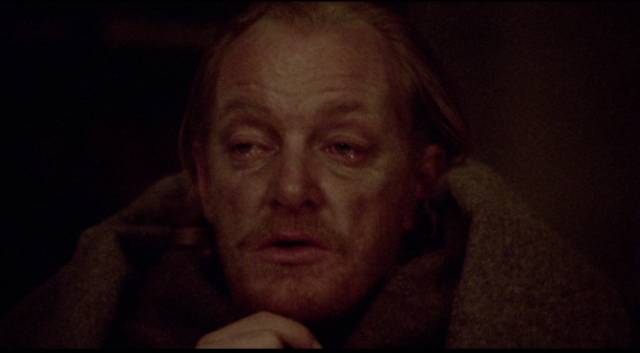
Matching Sellers note for note is Charles Aznavour, whose Visconti takes the situation with a lighter air of acceptance than the others as if he’s experienced so much already that this is just the next thing which has to be coped with. Jeremy Kemp, Peter Vaughan, Per Oscarsson, Nicholas Jones and Leon Lissek are all equally as strong.
Dark and hopeless as it is, I really liked The Blockhouse, though I completely understand why no distributor wanted to touch it. Now, almost fifty years after it was made, it may have more appeal for audiences no longer bound by expectations raised by the presence of Sellers – in fact, his presence may well attract a new audience interested in seeing an unfamiliar aspect of his talent.
Indicator’s Blu-ray is up to their usual standard, the transfer supporting the very dark photography without losing definition. There are several interviews on the disk – executive producer Kent Walwin on the difficulty of making a feature on a very low budget (18:18); production manager Matthew Raymond (11:47) and electrician Peter Bloor (9:33) on the logistics of shooting in the actual bunker, a dark, dirty, unhealthy location; Rees’s widow Gilda and son Fred on his passion for the project (12:52); and actor Leon Lissek on the difficulties faced by the cast (5:45). There’s also a short Crown Film Unit documentary about the occupation of the Channel Islands made shortly after their liberation (16:19).
Comments